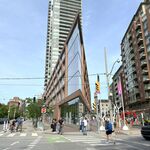subway safety
New Member
It sure is easy to second guess yourself, when it comes to the efficiency part of the innovation for the station skipping stuff.
There are once again 3 pieces 1. "separated passenger flow" for single sided platforms, with TTC already taking this, indicates I am on the right track.
2. Extreme cost effective platform safety (which is not available unless using my invention portion).
and 3. is the fun stuff: A new strategy I came up with because of affordable and feasible platform safety which opens a whole new realm.
Think of it like a Metronome. If is is set on slow speed, you only have the pointer passing through the centre section only so many times per minutes.
It is at slow speed ( relative to trains, because of a track fire, a suicide death, a PAA Alarm, or just bottlenecking on the system, sitting in the tunnels, or lastly in this case because of the added delays of so many stations to pick up etc.)
This design of stategic station skipping allows like the metronome to operate a whole lot faster, thereby the pointer passes through the centre point twice as often.
In other terms, the average speed goes from (it's rated on some document somewhere, don't have it handy), but say the average speed goes from about 27 to 54 kilometres an hour, this is the 203% improvement capability having nothing to change in headway time. At some point, once again for ultimate mazimization, atc may provide the full benefit of the 203%.
If you drive straight end to end at 88 kilometres an hour. It should only take 35.768 minutes. Then you add the time for your strategicly planned stops.
Station skipping is only safe and possible with platform safety. Today it takes about 105 minutes end to end. That's includes the Yonge Bloor changes, that I instigated.
Sharon.
There are once again 3 pieces 1. "separated passenger flow" for single sided platforms, with TTC already taking this, indicates I am on the right track.
2. Extreme cost effective platform safety (which is not available unless using my invention portion).
and 3. is the fun stuff: A new strategy I came up with because of affordable and feasible platform safety which opens a whole new realm.
Think of it like a Metronome. If is is set on slow speed, you only have the pointer passing through the centre section only so many times per minutes.
It is at slow speed ( relative to trains, because of a track fire, a suicide death, a PAA Alarm, or just bottlenecking on the system, sitting in the tunnels, or lastly in this case because of the added delays of so many stations to pick up etc.)
This design of stategic station skipping allows like the metronome to operate a whole lot faster, thereby the pointer passes through the centre point twice as often.
In other terms, the average speed goes from (it's rated on some document somewhere, don't have it handy), but say the average speed goes from about 27 to 54 kilometres an hour, this is the 203% improvement capability having nothing to change in headway time. At some point, once again for ultimate mazimization, atc may provide the full benefit of the 203%.
If you drive straight end to end at 88 kilometres an hour. It should only take 35.768 minutes. Then you add the time for your strategicly planned stops.
Station skipping is only safe and possible with platform safety. Today it takes about 105 minutes end to end. That's includes the Yonge Bloor changes, that I instigated.
Sharon.




